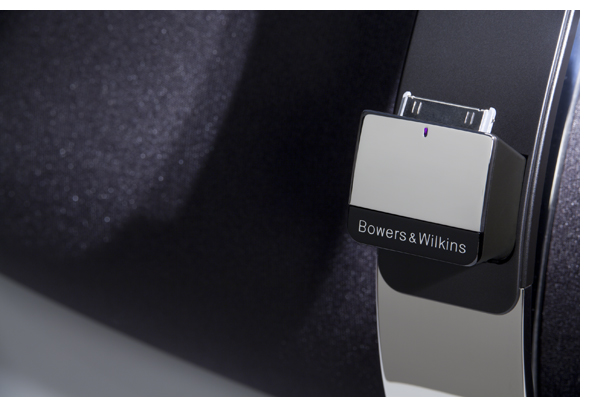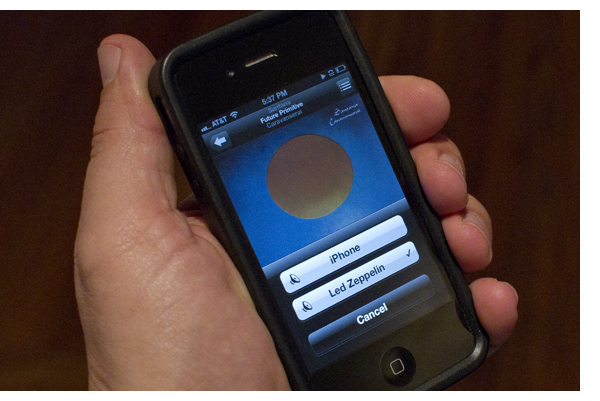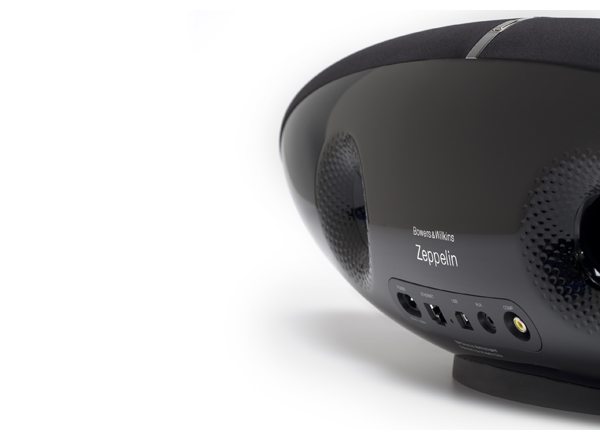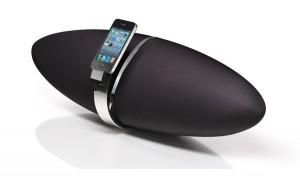B&W’s Zeppelin Air The iPod Soars to New Heights
By Jeff Dorgay
B&W began a revolution of sound, style and function in 2008 with the original Zeppelin. Competing with a plethora of cheapo iPod docks that sounded dreadful, B&W created an aural and visual tour de force, functioning much more than an iPod dock, with multiple inputs (line level, USB, Toslink and S-Video) to make the Zeppelin a true compact hifi system.
Past and present models look virtually identical, with only subtle differences between them. The first generation Zeppelin has a polished aluminum rear face, where the Air sports black. Around front, the iPod cradle now says “Bowers and Wilkins” where it said “B&W” before, but you won’t really need that cradle anymore. The cradle indicator LED now glows purple, meaning you are connected wirelessly to your iPhone, iPod or iPad, once you’ve taken a few minutes to enable AirPlay.
 While our original Zeppelin survived teenager torture for four years, everyone sighed a huge sigh of relief thanks to AirPlay, knowing there would be no more rough and tumble with the dock. The wireless connectivity also makes for a ton of fun when friends visit – now everyone can play their music through the Zeppelin Air.
While our original Zeppelin survived teenager torture for four years, everyone sighed a huge sigh of relief thanks to AirPlay, knowing there would be no more rough and tumble with the dock. The wireless connectivity also makes for a ton of fun when friends visit – now everyone can play their music through the Zeppelin Air.
And What a Sound it Makes
The original Zeppelin redefined tabletop possibilities with its 2.1 speaker system, consisting of a centrally located woofer (powered by a 50 watt amplifiers) with a pair of Kevlar midrange drivers and dome tweeters (powered by a 25 watt amplifier per channel) derived from B&Ws 800 series of home speakers.
Those wanting to peruse some cool video clips with in-depth technology assessments can click here:
Everything in the Zeppelin Air has been upgraded. The internal DAC is now able to play 24/96 files native (through the digital line input) and upsamples everything else to this resolution, along with the ability to grab the digital bitstream straight from the iPod, instead of merely using the line level output as the original model did.
Side by side, comparing the new and old Zeppelin is like comparing the Jaguar XK and XKR – most of the differences are under the hood. The speakers have been upgraded and now each one of the four drivers has its own 25 watt amplifier, rather than each midrange and tweeter pair sharing one. This is evident the minute the volume climbs above a whisper – and much like the two Jags, you don’t realize how handy that extra power is until you climb back into the lesser car. The Zeppelin always did an excellent job with heavy music, but now when playing hard rock or heavy hip hop, it provides a thunderous presentation.
The sublime seperaration between the bass line and guitars when playing Tool now makes the Zeppelin a serious metal machine. With a tiny bit of room reinforcement on the kitchen countertop, “Intolerance” (from the Undertow album) fooled a few dinner guests into thinking the theater system in the other room was on. And yes, I play metal when I’m cooking. The increased bass response and power will appeal to those in the latter category as well, the deep synth bass pervading MIDIval PunditZ “Atomizer” had the cutlery rattling in a way the original never could.
 Horsepower without finesse is uninteresting (or perhaps a Dodge Viper) and again the Zeppelin Air glides through effortlessly. The piano solo on Bowie’s “Aladdin Sane” from the self titled album was brilliant and hung in the air well in front of the speakers possessing exceptional timbral accuracy. Whatever secrets lurk in the DSP processing, the engineers in charge should get a pay raise. If I only had $600 to spend on a system, I wouldn’t even bother with separates. Those in a compact space will find that the Zeppelin Air makes a great addition to your flat screen TV for a lot less than any number of soundbars now available.
Horsepower without finesse is uninteresting (or perhaps a Dodge Viper) and again the Zeppelin Air glides through effortlessly. The piano solo on Bowie’s “Aladdin Sane” from the self titled album was brilliant and hung in the air well in front of the speakers possessing exceptional timbral accuracy. Whatever secrets lurk in the DSP processing, the engineers in charge should get a pay raise. If I only had $600 to spend on a system, I wouldn’t even bother with separates. Those in a compact space will find that the Zeppelin Air makes a great addition to your flat screen TV for a lot less than any number of soundbars now available.
To Dock or Not to Dock
Handy as Air Play is, if the music on your iPod has been stored in Apple Lossless or uncompressed format, there’s a real advantage to plugging in – the new DAC takes the digital bitstream directly from the player, bypassing the one in the iPod.
It will only take a second to make you a believer in the cause of higher resolution. The Zeppelin Air sounds deflated when you go back to MP3’s – it’s that performance thing again. Should you be a real digital audio geek, you can import 24/96 files via the optical input and Mac Mini. The Zeppelin has enough resolution to showcase high res files, and some of my favorite downloads from HD Tracks and the B&W Society of Sound websites were even more exciting than playing from the iPod in 16/44.1 mode. Miles Davis’ horn on the title track from Tutu, exploded from the Zep, full of life and resonance.
Having both wired and wireless modes available makes the Zeppelin Air easily adaptable to however you’d like to listen. AirPlay is perfect for casual listening, yet you can achieve substantially higher quality plugging your device directly in.
I’m Neither Dazed nor Confused
I’ve made it all the way through this review without making any reference to that great band with the same name, but my Anti-Zeppelin muscles can only stay flexed for so long. I wound up the evaluation with “Stairway to Heaven.” I couldn’t resist, and it was awesome.
Kidding aside, we are proud to award the B&W Zeppelin Air one of our Exceptional Value Awards for 2012. The worlds best iPod dock goes from marvelous to monstrous and in four years, the price has stayed the same, at $599. The Zeppelin Air rules.
 The B&W Zeppelin Air
The B&W Zeppelin Air
MSRP: $599
www.bowers-wilkins.com



